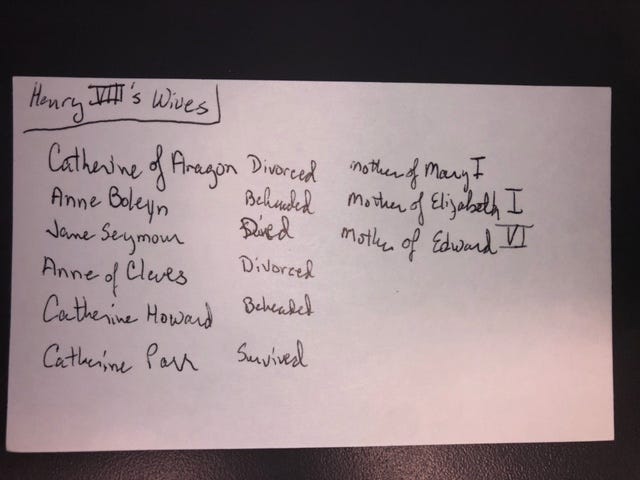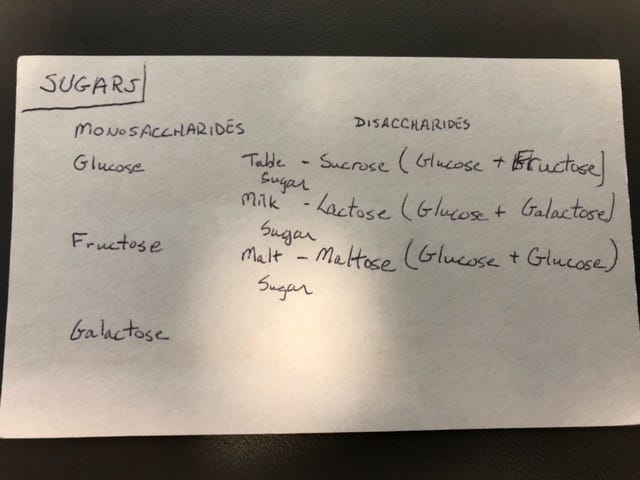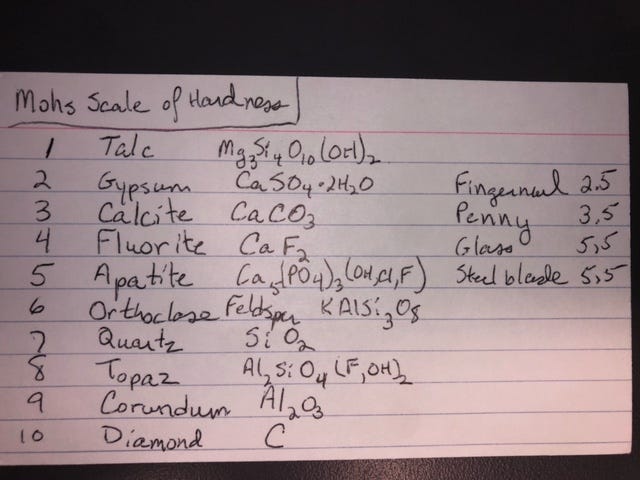During some exploration for clues to turn into questions, I ran into this reference
Spanish white: bismuth oxychloride, BiOCl, or oxynitrate, BiONO3
on an old website, which I had found years ago and forgotten about. Archaic terms often show up as later clues for common household chemicals, and though it's not official chemical knowledge, it's something that could allow someone to answer a chemistry question after those more experienced in the field have their chance. Archaic terms of former names in general sit in that early to middle clue position for high school questions, so any glossary like this could be mined for information. This bismuth mention was surprising to me since I had thought of this archive not as archaic terms but exclusively as medieval and ancient terms, and I knew bismuth was a later discovery. So I started to consider whether I should use this clue. I decided not to, but the exact reasoning by which I came to that conclusion is a good course in the study of why some things aren't asked, and aren't used as clues.
The many ways in which Spanish white is described makes it problematic. If you have to phrase it as an oxynitrate of the element that's one thing, or the oxychloride of it it's another, but if it's possibly either of those, it's going to be harder to write into a question. Add to that that some other sources list it as a subnitrate (an archaic term for an oxynitrate), an carbonate, or a hydroxide nitrate. All of those could be true and could be used in a question, but because a question is recited orally, one of those clues has to be given first. And that first encountered clue in an “or” phrase dominates what comes after. The player encounters the first clue, and if they have learned it a different way, they are going to dismiss their impulse before the “or” is read. And if the clue they are familiar with comes after the or, they’ve whipsawed between an idea and rejecting it, making it unlikely they’d return to the idea of an answer they’d had.
At this point you'd be disinclined to use the clue at all, or you'd simplify the clue into something like: "salts of this element form the pigment Spanish White."
There's another source which assigns Spanish White to a mix of bismuth salts and lead salts. Here you see the problem is more direct. Once you add another possibility of the cation being something else, you can't use this clue to establish the question is uniquely identifying bismuth. And here's where the it gets interesting again. Because lead was known to the ancients and bismuth was discovered as an element in the 1700's, it's very possible that the pigment Spanish white was a mix of the two. A process of chemical separation of the two would not have been developed at this point. This is even borne out by some historical records which asserted that miners classified three types of lead ore, one of which describes a type with the properties of bismuth.
If you search for "Spanish White bismuth" you'll be led to all of these clues and find the problems in the first paragraph there, but if you then search for "Spanish White lead" you will be led completely down paths not relating to the pigment, but to "White lead" is Spain, without really referring to the pigment. To find that hitch that makes it ambiguous you have to run into the source that lists the mix. But it's an ambiguity that you have to search out to know it’s there.
If you searched out more, you run across Blanc d'Espagne, a pun on the term "Spanish white" as it was used in 1880's France. And in that description it brings a third interpretation of the contents of Spanish white: chalk and clay used as an abrasive cleanser or cosmetic. Obviously this would be another ambiguity that could push a history player toward a completely different set of answers.
The short form of this would be to simply say the clue is a tangle of varying levels of correctness, but it's an interesting tangle that helps illustrate a couple of points. The term referred to an ambiguously composed substance, then scientific discovery removed some of that ambiguity, then the term evolved to be linked to different substances, and gained a different meaning and reference specifically in another language from the term's attribution, or the language the clue would be used in. I think I have never run into a clue that's difficult to use in so many distinct ways. It's not impossible to use this knowledge, it's that to put the specific details of this clue, removing its ambiguities, would take more space in the question than I would feel comfortable using.
I've detected a pattern in some of my ideas for developing a new team. I'm very much fixated on the idea that you should be achieving a circular development pattern, where more experienced players help new players to develop by building a repository of training material (in past newsletters, I've suggested this for practice questions, media links, flashcards for Anki or Quizlet, study guides, and most recently index cards.) But I haven't really spent much time in the process of giving you or the readers of the book starting material to give the idea a starting point.
With the exception of the questions that I compiled from links from the previous week for most of 2020-2022, I haven't really been focusing on the product that has to be created, rather I've been going at the process of creation. But each of these products needs a kind of template to determine which particular format is appropriate to the information to be contained, and the amount of effort required to produce them. Each format also demands a certain level of experience to know what's appropriate and sufficient to include.
Flashcard decks are appropriate where there's one question or set of facts that all lead to a single answer, and you want to group them appropriately. You could easily fit the questions of a television program into a flashcard deck and have it available for study in subsequent years, or to get the players’ minds clear on the types and patterns of questions that get used on the program. But each individual flashcard points at one and only one target and one direction of thinking about clues and answers.
Study guides need to be full page coverage of a subject. Whether that is a coverage of a broad subject or a narrowly focussed topic, it needs to cover the answers in the field. What I talked about shots in the first book, I always envisioned them mapped out on a full size page, allowing you to follow the information in any direction. When you knew the whole study guide you could follow the question wherever it tried to lead you.
Index cards, which I mentioned two weeks ago, fall between these two points. They should be written to contain multiple facts, and can lead to multiple answers and questions being derived from the information. But they wouldn’t constitute a complete study of a general category, and they may not have all the information you could expect in a question about the subject. An index card could be created by you the coach, or by a student looking to pass on their knowledge to their teammates, and because we should account for that possibility, we have to modify the expectations of what the card can be.
The cards should seem achievable, compact, and not exhaustively detailed. The reason I say this is you want something that a new student can feel like they could either learn from cards already created or contribute to the effort of generating the cards. They should not be designed to educate the specialist, they are designed to help broaden out a player into a generalist, or to fill a hole in a player's knowledge. And cards should have some part of a jumping off point, to encourage the curiosity of the player who picks it up after its creation.
Where I have been lax in this process of creating index cards for myself is that I've been overwhelmingly concerned with starting these at the beginning level. And in trying to hit that very beginning, very inexperienced level, I haven’t been as productive as I think I need to be.
I had taken these from a stack I wrote a couple years ago, and I’m going to focus on the Wives of Henry VIII because it’s the one that the general population would think of as quiz bowl. It’s also the one that needs the most work. (You are of course welcome to either copy or transcribe these to start a collection of cards for your students.)
The detail that needs to be included is a reference to why this subject is important and why should they care. For instance, this card needs a simple inclusion stating “King of England 1509-1547.” While it is obvious to the writer why this card was created, (because these people are asked about in questions,) a new player might not have the context. It’s better to give the context and have it be duplicate information than to treat the information as an isolate. Without some connections established, the player can only use the knowledge gained in a single context.
We also can’t have it be merely a table of information, there needs to be something additional that inspires curiosity. The mentions of the three monarchs who followed Henry on the throne are there to encourage players to ask “what about them?” In addition to a context for Henry, I think the years of their reigns would be a big context clue to their importance.
As another way of attacking this, I’d like to see how a study guide or existing infographic could be reduced.
For high school competitors, I'd take this infographic about the chemistry of vinegar, and reduce it down to five or six points:
acetic acid - HC2H3O2 - primary acid in vinegar
fermentation - converting sugar to alcohol (specifically in this case into ethyl alcohol/ethanol.) First step in vinegar production.
acetification - process by which ethanol (C2H6O) is converted to acetic acid, intermediate step acetylaldehyde. Second step in vinegar production. An oxidation process.
malic acid - named for apples, present in apple cider vinegar
lactic acid - HC3H5O3 - named for its presence in milk, present in malt vinegar
balsamic vinegar - product of aging grape must after acetic acid is formed.
That should fit on an index card, and be sufficiently detailed and informative for a player who isn’t yet in a chemistry class. I'm ambivalent about whether to include a note about tartaric acid and its role in the discovery of enantiomers and stereochemistry. While that's good for someone in a second-year chemistry class, it's less good part of as your introduction to one of the most common organic compounds.
Part of the idea of doing cards is simply to get information into your own head by transcribing and evaluating the information. Note-taking is a study skill that is taught in lots of research-based classes in high school. But where this technique exceeds that is in teaching the creators how to hone their presentation, their evaluation of information, and their note-taking process not merely to benefit the creator of the note, but those who read it later. The creator of the index card learns the material, and then they teach someone else through their work. It invests them with being part of the process of the whole team’s growth and development, and moves their motivation beyond self-improvement and into team improvement.





